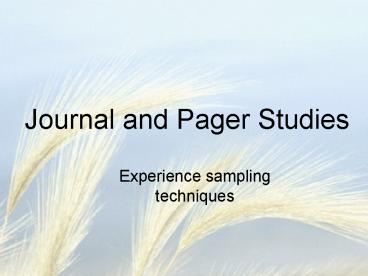Journal and Pager Studies - PowerPoint PPT Presentation
1 / 18
Title:
Journal and Pager Studies
Description:
Taken from psychology: Thought sampling. Experience sampling method (ESM) ... Detail, color, auditoriness, interior monologue) Experience Sampling Method ... – PowerPoint PPT presentation
Number of Views:45
Avg rating:3.0/5.0
Title: Journal and Pager Studies
1
Journal and Pager Studies
- Experience sampling techniques
2
Agenda
- Questions
- IRB Update
- Overview of sampling techniques
- Pager studies
- Diary studies
3
IRB proposals
- If asked who is going to sign off on the
proposal, use the name Elizabeth Mynatt
4
Overview
- Can be formative or summative
- Depends on types of questions
- Format of study
- Uses of results
- Qualitative or quantitative methods
- Pager/beeper sampling
- Journal/diary studies
5
Goals
- Understand experience in natural settings
- Better understanding of experience over time
- Remove constraints of more structured methods
6
Types of beeper sampling methods
- Taken from psychology
- Thought sampling
- Experience sampling method (ESM)
- Descriptive experience sampling
7
Benefits of beeper sampling
8
Thought Sampling
- Uses random paging
- Series of questionnaires to determine mental
content - 24 4-point scales for features of thought
- (eg. Detail, color, auditoriness, interior
monologue)
9
Experience Sampling Method
- More general than thought-sampling
- Does not necessarily measure thought variables
- Focuses on context of experience
- Where are you? With whom? What are you doing?
- Often uses Likert scales or multiple choice to
assess experience
10
Descriptive Experience Sampling
- Qualitative (no Likert scales!)
- Encourages study participants to develop their
own descriptive language - Less constraint on user responses
11
Limitations
- Certain populations unwilling to carry pager
- How much time between page and response?
- Potential for post-hoc rationalization
- Potentially inconvenient
- Random or timed paging may miss important
experiences
12
Pager study design factors
- How often to page
- How much time between page and response
- Random or regular paging
- Question content and format
13
Benefits
- Asks users to report what they were doing before
the page - Users less likely to modify behavior
- Can collect data at any time no observer needed
- Can help get at tacit knowledge
14
Diary/Journal studies
- Qualitative method
- Participant creates logs of activities
- Generally gives control of data collection to
participant - Also good for collecting data over time
15
Diary study design factors
- Structure of questions
- Record all activities or questions about specific
activities? - Prescribed time to log, or left up to
participant? - Once a day? Every time you use a system?
- Means of recording
- Writing, web entry, audio, photographs?
16
Benefits of diary studies
- Non-intrusive, non-interrupting
- Participants log at their convenience
- Potential for detailed, interpreted answers
- Not random
- participants will report most significant
information
17
Limitations
- Relies on participants to remember to log
- Amount of information will vary with
participants motivation - Much time may elapse between experience and
reporting - Potential for post-hoc rationalization
18
Upcoming
- Monday Ubicomp
- Weiser article on web be prepared to discuss






























